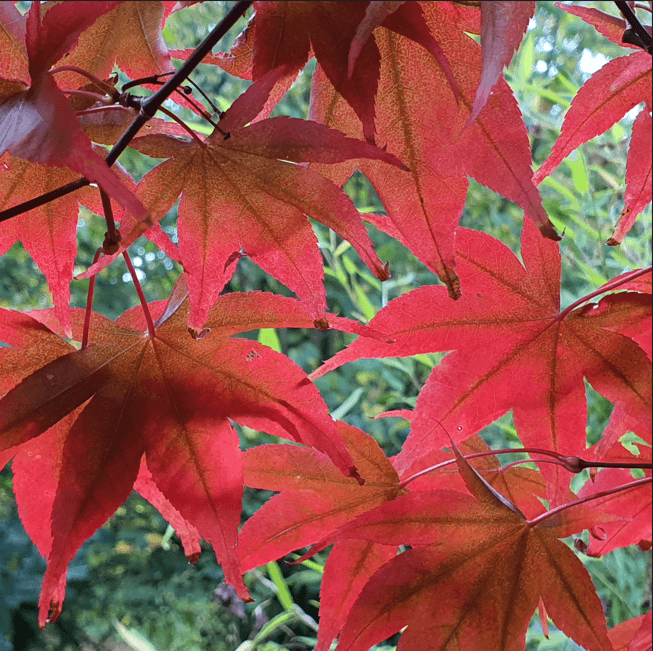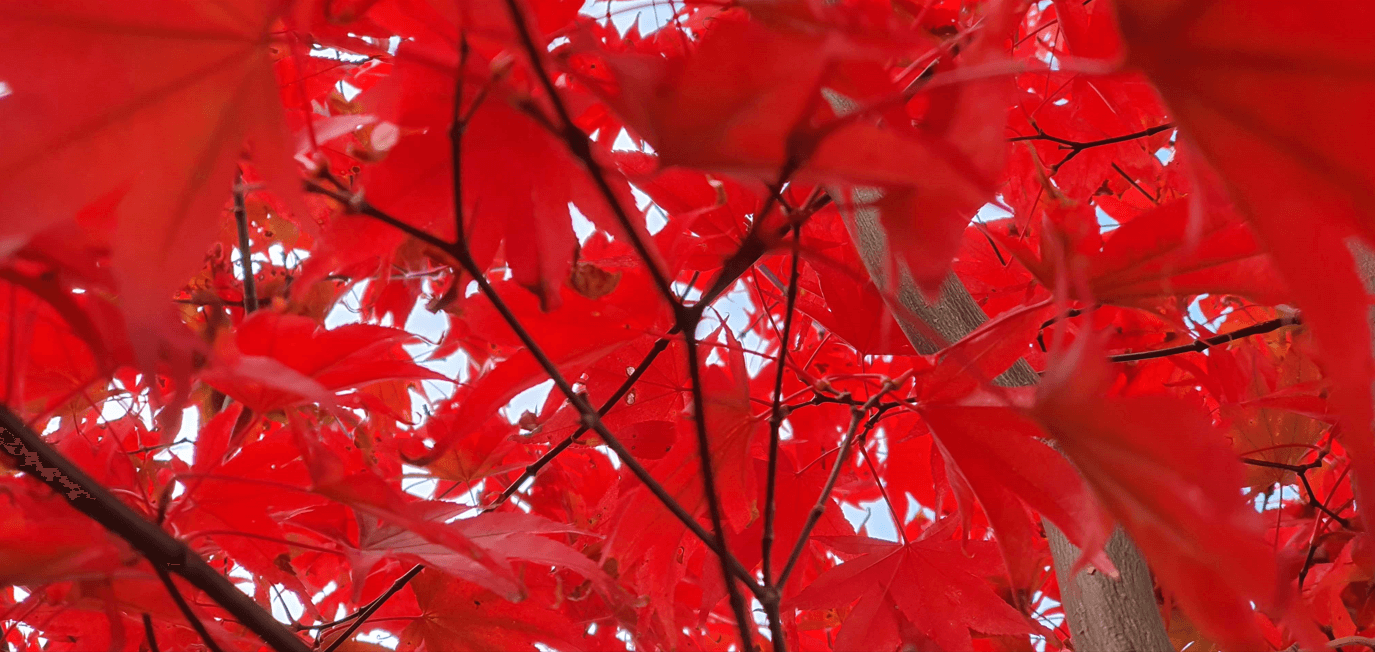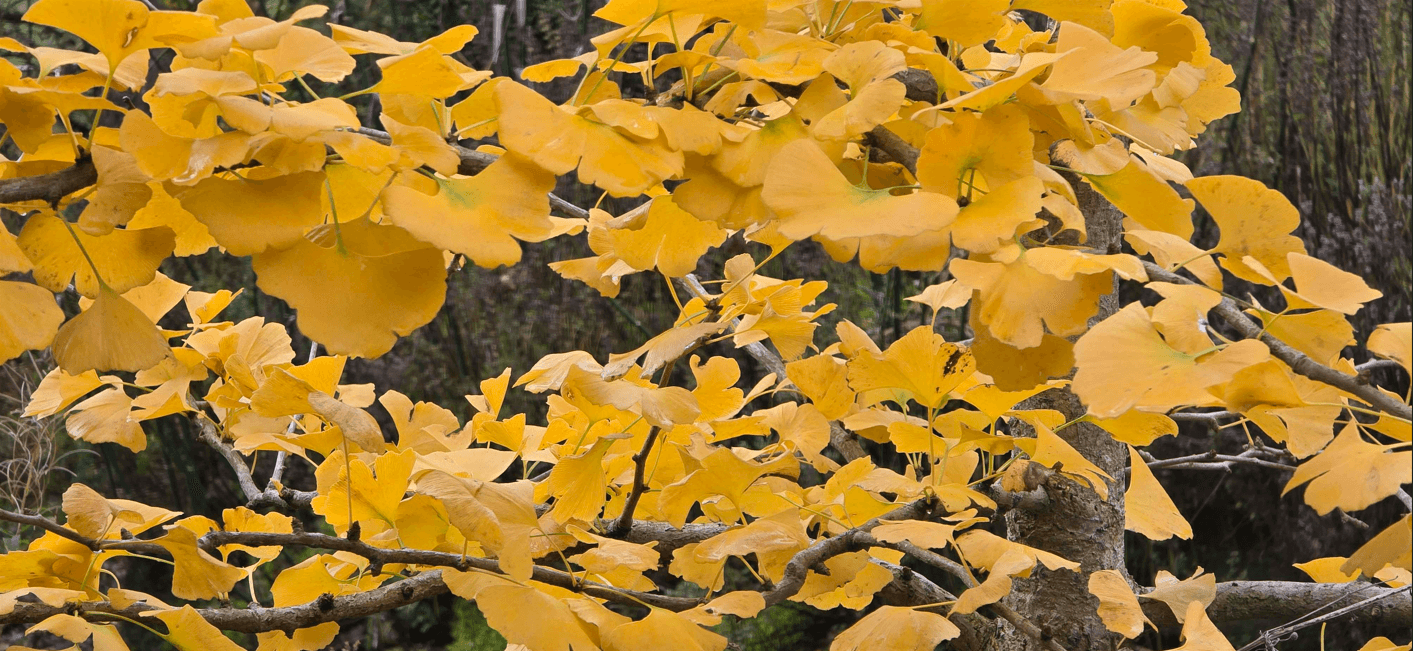Autumn Colour at Kilgraney Herb Gardens: Japanese Maple and Ginkgo
In the thirty-two years we’ve called Kilgraney our home we’ve planted many trees around the property. Although the gardens are closed this time of year, we’re are blessed with some wonderful autumnal colours.
As the days shorten and the first frosts appear, trees put on one of nature’s most spectacular shows. Few things rival the joy of seeing trees that truly come into their own in autumn and we have two favourites, a Japanese Maple (Acer palmatum), a house warming gift from former work colleagues at Kilkenny Design Workshops, and Ginkgo trees (Ginkgo biloba) we planted in our medicinal herb gardens in 2003. Both bring warmth and beauty to the gardens and courtyards at Kilgraney House creating a striking contrast against the more muted colours of the season.
Here, we’ll take a closer look at these two remarkable trees and why they may deserve a place in your own garden.
Japanese Maple, Acer palmatum
For centuries, Japanese Maples have been treasured for their delicate, lacy leaves and their vibrant fall colours. In the autumn, Acer palmatum varieties can turn brilliant shades of red, orange, or purple. Japanese Maples are compact enough for smaller gardens, and their fine, elegant branches bring an architectural beauty to any landscape.
But the magic of the Japanese Maple isn’t just in its colour—it’s also in the fascinating science of autumn. As the weather cools and sunlight lessens, chlorophyll (which gives leaves their green colour) breaks down, revealing the leaf’s “true” colours underneath. In the case of the Japanese Maple, this hidden beauty is a stunning scarlet or crimson, like a hidden treasure waiting to be revealed.
Planting Tips: Japanese Maples thrive in partial shade and prefer well-draining, slightly acidic soil. Because they can grow in pots, they’re also a great choice for patios and smaller spaces. Look for varieties like ‘Bloodgood’ or ‘Red Emperor’ for particularly intense autumn colours.
Ginkgo, Ginkgo biloba
If you’re looking for something unique, the Ginkgo tree offers beauty, history, and resilience all in one. Known as a “living fossil,” the Ginkgo tree has existed virtually unchanged for over 200 million years, making it one of the oldest tree species on Earth. Its fan-shaped leaves, unlike any other in the plant world, have an unmistakable charm.
During the growing season, the Ginkgo’s leaves are a lovely shade of green. But with the first frosts of autumn, this tree becomes a showstopper, transforming into a bold golden-yellow colour that can brighten even the gloomiest day. This colour shift happens almost overnight, creating an impressive display of nature’s artistry.
Planting Tips: Ginkgo trees can reach significant heights, so they’re ideal for larger gardens, but they’re relatively slow growers. They tolerate urban pollution and poor soil, making them low-maintenance and very resilient. Consider the ‘Autumn Gold’ cultivar for an especially radiant yellow display.
The Science Behind Autumn’s Colours
Just like the Acer, the Ginkgo colours in autumn are actually the tree’s “true” colours. Throughout the growing season, chlorophyll dominates, giving leaves their green hue as it powers photosynthesis. When temperatures drop, chlorophyll production slows down, and the hidden pigments in the leaves—carotenoids for yellows and reds from anthocyanins—begin to reveal themselves. This seasonal shift, triggered by light and temperature changes, gives us the vibrant autumn landscape we love.
Why Choose Trees for Autumn Interest?
Adding trees with rich autumn colours to your garden brings more than beauty. Trees like Japanese Maple and Ginkgo introduce layers of texture and colour, and they also enhance the ecosystem, attracting birds and beneficial insects.
Start Your Own Autumn Show
Why not bring the beauty of Japanese Maple and Ginkgo into your own garden? Whether you have space for just one or both, these trees reward with seasonal interest, unique textures, and colours that make autumn days unforgettable.
So be sure to visit your local garden centre, chat with fellow garden enthusiasts, or plan a visit to one of the gardens featured in the Carlow Garden Trail to see trees in all their autumn splendour.




